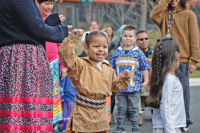Paddling downturn forces NOC to expand offerings
 Of the many challenges faced by the Nantahala Outdoor Center during the past decade, one of the most troubling — and the most difficult to fix — has been a national decline in paddling.
Of the many challenges faced by the Nantahala Outdoor Center during the past decade, one of the most troubling — and the most difficult to fix — has been a national decline in paddling.
NOC’s steady and robust growth since its founding in 1972 through the late 1990s followed a similar trajectory to the sport in general. But after nearly three decades of growth, paddling leveled out around 2000 and even declined as a pastime.
“The whitewater industry, like any other industry, reached maturity. When it did, you saw a flattening of the market,” said Ken Howle, who worked at the marketing department of NOC during the ‘90s and early 2000s.
Paddling is showing signs of a turnaround, posting modest growth in the past couple of years, according to Mark Singleton, a former NOC employee and the director of American Whitewater, a national paddling advocacy group based in Sylva. The question is whether NOC is positioned to capitalize on the uptick.
Related Items
Paddling prowess
The Nantahala once reigned over the national paddling scene. While it is still a revered river, it doesn’t outshine the rest of the paddling world like it once did.
On one hand, the field has simply gotten more crowded. When NOC was started 40 years ago, it was one of only three river outfitters in the entire Southeast — hardly the case now as dozens of companies compete for the commercial rafting traffic.
Competition in the field of commercial rafting outfitters is only part of the story. The Nantahala isn’t challenging enough to capture today’s elite paddlers who have grown ever more sophisticated in their sport. Since the early days of careening down the Nantahala in aluminum canoes or canvas contraptions stretched over wooden frames, boat design has become a science.
Innovative kayak makers were building ever lighter, ever sturdier, ever swifter boats, tailoring them to handle specific types of whitewater, deploying nuances and subtleties of design unimaginable three decades ago.
Paddlers likewise have refined their skills, mastering the performance of both their own bodies and the physics of moving water. They were capable of running rapids once only the foolhardy would have attempted.
The Nantahala’s comparatively simple class II and III rapids just weren’t as fun and exciting for top-level paddlers as it once was.
“It becomes commonplace so you see people migrating from the Nantahala and up to West Virginia like the New or the Gauley,” Singleton said.
Meanwhile, NOC is no longer a cutting edge training ground for the elite competitive paddlers. It has watched from sidelines as artificial whitewater training centers have eroded the concentration of champion paddlers that once called the Nantahala home. The Whitewater Training Center in Charlotte that opened five years ago proved the biggest blow. It is one of the premium artificial whitewater courses in the country and practically in the Nantahala’s backyard.
Paddlers training for national championships and the Olympics began to relocate from the Nantahala to the new training center in Charlotte, along with the director and coach of the Nantahala Racing Club.
Of course, the top-level paddlers revere real rivers, and still come to them often, but the buzz and hype of championship paddlers calling NOC home has faded — indeed, the competitive athletic culture has diminished, according to Singleton, the director of American Whitewater.
While NOC still touts itself as the home of 22 paddling Olympians, it is increasingly relying on history to carry the claim, Dickert agreed.
Olympic whitewater competitions aren’t held on real rivers anymore, however. In fact, the 1996 games on the Ocoee was the last real river venue.
“You have the games in Sydney, the games in Athens and now games in London, and each of those Olympic venues is a pump park — a closed system loop where water is pumped up to the top and it flows down,” Singleton said.
NOC didn’t have the same caliber of whitewater, the training facilities or jobs to keep the athletes around, Singleton said. But, that had been the case for some time.
“Charlotte created an exit strategy for many of the top athletes,” Singleton said.
The artificial rivers also offer recreational raft trips to the public, adding to NOC’s competition.
“People thought that if anything it would build the industry and people would think I had this great experience, now let’s go to the mountains and do the real thing,’” Dickert said. “But, some people might do it and check off that box and say ‘Now let’s go do something else.’”
For NOC, the competition from Charlotte was a microcosm of the company’s larger dilemma.
“In a larger context, this is all about new product development, regardless of whether it is an outdoor experience or some other tourism product, NOC is still very much in the business of travel and tourism and the process of attracting visitors to their establishment,” Singleton said.
Borrowing a page from the theme park playbook, “there is a constant churn of new products,” Singleton said.
But in the early 2000s, NOC was still largely doing the same tried and true raft trips and kayak clinics.
“The current mix continues to get stale and the emphasis on new product development came too late, too short,” Singleton said.
Back in the game
NOC might have an ace in its hole yet, however.
A new kind of world championship is coming to the Nantahala this year and next, one that has given the Gorge a heightened energy for the first time in years.
The best freestyle paddlers in the world will descend on the Gorge for two years back-to-back — for the World Cup of Freestyle Paddling this September followed by the even bigger Freestyle World Championship next September.
It will put NOC in the international spotlight with this hip and rapidly growing segment of paddling, where kayakers do stunts and tricks while surfing in place on a wave.
The Gorge is in a frenzy getting ready for the big events — with the crown jewel being the installation of concrete contraption on the river bottom that kicks up a surfing wave on the surface.
“Outfitters are embracing something that puts the Gorge back on the map again,” Singleton said.
Landing the freestyle paddling Worlds was a huge score. Not only is the Wave drawing the top-level freestyle paddlers to train and practice, but it’s creating an allure for the paddling masses as well. And that’s where NOC can capitalize, offering sessions with its instructors and clinics.
“We can help you develop those same skills and do those tricks and help you have fun on the river in this world championship venue,” said Wayne Dickert, a longtime NOC paddling instructor. “You can have recreational boaters come and not feel terrified to play in it and feel some level of success.”
Sutton Bacon, the NOC president and CEO, said the Wave is the “preeminent whitewater freestyle feature in the United States.”
“It is a strong investment in broadening the appeal of the Nantahala from a beginner and intermediate river to a river where even experts and world champions feel at home,” Sutton said.
Meanwhile, the Gorge is poised to grab the attention of thrill-seeking paddlers looking for tougher, steeper rapids than the Nantahala has been able to offer in the past. Starting this year, a series of whitewater releases from the Nantahala Dam by Duke Energy will surge down the Upper Nantahala, a stretch now bypassed as water is diverted through pipes en route to hydropower generators. Duke will forgo generation for 15 days of the year and restore water to the Upper Nantahala for steep, challenging creek boating.
“It will allow folks to put them on their calendar and show up,” said Singleton, who was integral in lobbying for the Upper Nanty releases. “These new releases will add to the adventure tourism product mix of the region and provide whitewater paddlers with new boating opportunities consistent with contemporary paddle sports.”
Broader horizons
For NOC, the answer can’t merely be recapturing its title of top paddling river. It must do more to attract outdoor adventurers of all walks.
But diversifying isn’t new for NOC.
It’s arguably made strides to expand beyond rafting. Mountain biking has seen the most success, with Gorge-bound paddlers strapping on the bike rack more often than not when heading to NOC.
NOC has also pushed fly-fishing, and dabbled in outdoor photography workshops, wilderness survival clinics, yoga retreats — you name it.
But, successfully billing itself as more than a river outfitter won’t come overnight.













